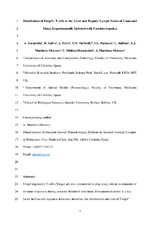Mostrar el registro sencillo del ítem
Distribution of Foxp3+ T cells in the liver and hepatic lymph nodes of goats and sheep experimentally infected with Fasciola hepatica
| dc.contributor.author | Escamilla, Alejandro | |
| dc.contributor.author | Zafra Leva, Rafael | |
| dc.contributor.author | Pérez, José | |
| dc.contributor.author | McNeilly, T.N. | |
| dc.contributor.author | Pacheco, I.L. | |
| dc.contributor.author | Buffoni Perazzo, Leandro | |
| dc.contributor.author | Martínez-Moreno, Francisco Javier | |
| dc.contributor.author | Molina Hernández, Verónica | |
| dc.contributor.author | Martínez-Moreno, Álvaro | |
| dc.date.accessioned | 2019-12-03T12:21:53Z | |
| dc.date.available | 2019-12-03T12:21:53Z | |
| dc.date.issued | 2016 | |
| dc.identifier.uri | http://hdl.handle.net/10396/19173 | |
| dc.description.abstract | Foxp3 regulatory T cells (Tregs) are now considered to play a key role in modulation of immune responses during parasitic helminth infections. Immunomodulation is a key factor in Fasciola hepatica infection; however, the distribution and role of Foxp3+ Tregs cells have not been investigated in F. hepatica infected ruminants. The aim of this study was to evaluate the presence of Foxp3+ Tregs in the liver and hepatic lymph nodes from experimentally infected sheep and goats during acute and chronic stages of infection. Three groups of goats (n = 6) and three groups of sheep (n = 6) were used in this study. Goats in groups 1–2 and sheep in groups 4–5 were orally infected with metacercarie of ovine origin. Groups 1 and 4 were killed during the acute stage of the infection, at nine days post infection (dpi); groups 2 and 5 were killed during the chronic stage, at 15 and19 weeks post infection respectively (wpi). Groups 3 (goats) and 6 (sheep) were left as uninfected controls. Fluke burdens and liver damage were assessed and the avidin–biotin–complex method was used for the immunohistochemical study. At nine dpi in acute hepatic lesions, the number of both Foxp3+ and CD3+ T lymphocytes increased significantly in goats and sheep. In the chronic stages of infection (15–19 wpi), the number of Foxp3+ and CD3+ T lymphocytes were also significantly increased with respect to control livers, particularly in portal spaces with severely enlarged bile ducts (response to adult flukes) while the increase was lower in granulomas, chronic tracts and smaller portal spaces (response to tissue damage). Foxp3+ Tregs were increased in the cortex of hepatic lymph nodes of sheep (chronic infection) and goats (acute and chronic infection). The estimated proportion of T cells which were Foxp3+ was significantly increased in the large bile ducts and hepatic lymph node cortex of chronically infected goats but not sheep. This first report of the expansion of Foxp3+ Tregs in acute and chronic hepatic lesions in ruminants suggests that these cells may be involved in both parasite survival and modulation of hepatic damage. Future studies should be focused on the investigation of parasite molecules and cytokines involved in this process. | es_ES |
| dc.format.mimetype | application/pdf | es_ES |
| dc.language.iso | eng | es_ES |
| dc.publisher | Elsevier | es_ES |
| dc.rights | https://creativecommons.org/licenses/by-nc-nd/4.0/ | es_ES |
| dc.source | Veterinary Parasitology 230, 14-19 (2016) | es_ES |
| dc.subject | Sheep | es_ES |
| dc.subject | Goat | es_ES |
| dc.subject | Foxp3 | es_ES |
| dc.subject | Immunohistochemistry | es_ES |
| dc.subject | Fasciola hepatica | es_ES |
| dc.title | Distribution of Foxp3+ T cells in the liver and hepatic lymph nodes of goats and sheep experimentally infected with Fasciola hepatica | es_ES |
| dc.type | info:eu-repo/semantics/article | es_ES |
| dc.relation.publisherversion | http://dx.doi.org/10.1016/j.vetpar.2016.10.020 | es_ES |
| dc.relation.projectID | info:eu-repo/grantAgreement/EC/H2020/635408 (PARAGONE) | es_ES |
| dc.relation.projectID | Gobierno de España. AGL2015-67023-C2-1-R | es_ES |
| dc.rights.accessRights | info:eu-repo/semantics/openAccess | es_ES |

